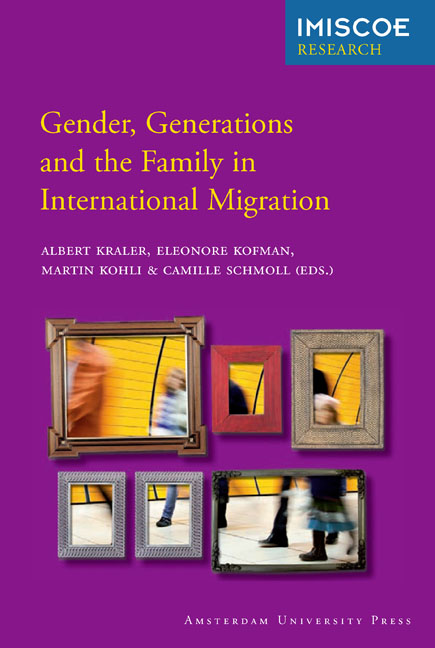Book contents
- Frontmatter
- Contents
- Preface
- 1 Introduction: Issues and Debates on Family-Related Migration and the Migrant Family: A European Perspective
- Section I The Family as a Moral and Social Order
- Section II Gender, Generation and Work in the Migrant Family
- Section III Marriage Migration and Gender Relations
- Section IV Transnational Family Lives and Practices
- List of Contributors
- Index
- Other IMISCOE titles
8 - Spousal Reunification Among Recent Immigrants in Spain: Links with Undocumented Migration and the Labour Market
Published online by Cambridge University Press: 21 January 2021
- Frontmatter
- Contents
- Preface
- 1 Introduction: Issues and Debates on Family-Related Migration and the Migrant Family: A European Perspective
- Section I The Family as a Moral and Social Order
- Section II Gender, Generation and Work in the Migrant Family
- Section III Marriage Migration and Gender Relations
- Section IV Transnational Family Lives and Practices
- List of Contributors
- Index
- Other IMISCOE titles
Summary
Introduction
In 2007, one of the most widely read Spanish newspapers published the following headline: ‘Family reunification opens the door to 245,000 new immigrants in only three years. The government says a second stage in the migratory process is starting’ (Bárbulo 2007). Spain's Secretary of State of Immigration stated that this increase in the number of foreigners who had been granted a residence permit on the basis of family reunification must be seen as a good sign because ‘[…] family reunification is a factor that promotes settlement’ and ‘[…] favours integration into the host society and reduces the immigrants’ risk of social isolation’. In the same vein, some immigration scholars said that this trend would continue in the near future since ‘family reunification is practiced by people who have consolidated their migration project after achieving economic stability and social integration’ (Bárbulo 2007).
These statements indirectly suggest that labour immigration to Spain is progressively declining as many migrants, who initially came as temporary workers, extend their stay and start to bring their families over for the purpose of settlement. Accordingly, family reunification is described as a secondary flow that is initiated once first-movers have lived in the immigration country long enough to make the necessary arrangements to send for their relatives. As a result of this view, family-linked immigration is often equated to legal family reunification and ‘de facto’ family reunification is completely neglected, which, in turn, reinforces the view of family-linked migration as a secondary flow. In countries where undocumented immigration has become a chronic and structural feature, as in the case of Spain, this view might be particularly misleading in describing and understanding the household dimension of international migration and integration. Moreover, as Creese et al. (this volume) also mention, such a view tends to obscure the flexibility of the immigrant household to adopt responsive strategies to changing circumstances, becoming a central lynchpin to successful integration.
To shed some light on these issues, I have used both official aggregate statistics and survey data to examine the size and pace of the family reunification process in Spain, as well as to analyse whether different family migration patterns are associated with differences in the behaviour of foreign immigrants in the host labour market.
- Type
- Chapter
- Information
- Gender, Generations and the Family in International Migration , pp. 193 - 218Publisher: Amsterdam University PressPrint publication year: 2012
- 3
- Cited by



